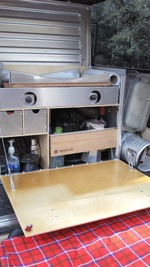
Overland Tech and Travel
Advice from the world's
most experienced overlanders
tests, reviews, opinion, and more
Tested: 2012 Yamaha Super Ténéré
 Photos by Tom Riles and Brian Nelson
Photos by Tom Riles and Brian Nelson
If it’s Tuesday, it must be Timbuktu!
by Ken Freund
 Reprinted with permission, RoadRUNNER MagazineYamaha has been selling this new Super Ténéré adventure-touring model in Europe for several years now and is finally bringing it to North America. Ténéré (pronounced like “tay-nay-ray”) is the word for “desert” in the language of the Tuareg tribe that resides in the region of the Sahara where Timbuktu is located. The first bike to carry the Super Ténéré name was the 1989 XTZ750 twin and it won the trans-Saharan Dakar Rally six times — so this new machine has good DNA!
Reprinted with permission, RoadRUNNER MagazineYamaha has been selling this new Super Ténéré adventure-touring model in Europe for several years now and is finally bringing it to North America. Ténéré (pronounced like “tay-nay-ray”) is the word for “desert” in the language of the Tuareg tribe that resides in the region of the Sahara where Timbuktu is located. The first bike to carry the Super Ténéré name was the 1989 XTZ750 twin and it won the trans-Saharan Dakar Rally six times — so this new machine has good DNA!
 Photos by Tom Riles and Brian Nelson
Photos by Tom Riles and Brian Nelson
If it’s Tuesday, it must be Timbuktu!
by Ken Freund
 Reprinted with permission, RoadRUNNER MagazineYamaha has been selling this new Super Ténéré adventure-touring model in Europe for several years now and is finally bringing it to North America. Ténéré (pronounced like “tay-nay-ray”) is the word for “desert” in the language of the Tuareg tribe that resides in the region of the Sahara where Timbuktu is located. The first bike to carry the Super Ténéré name was the 1989 XTZ750 twin and it won the trans-Saharan Dakar Rally six times — so this new machine has good DNA!
Reprinted with permission, RoadRUNNER MagazineYamaha has been selling this new Super Ténéré adventure-touring model in Europe for several years now and is finally bringing it to North America. Ténéré (pronounced like “tay-nay-ray”) is the word for “desert” in the language of the Tuareg tribe that resides in the region of the Sahara where Timbuktu is located. The first bike to carry the Super Ténéré name was the 1989 XTZ750 twin and it won the trans-Saharan Dakar Rally six times — so this new machine has good DNA!
Powertrain
Power is supplied by a liquid-cooled 1199cc parallel-twin engine unique to this model, which is rated 108.4 hp in Europe (US specs don’t list power). With an 11.0:1 compression ratio, it breathes through four-valves-per-cylinder and has a DOHC shim-under-bucket valve train that boasts 24,000-mile service intervals. Twin 46mm Mikuni EFI throttle bodies feed fuel through 12-hole injection nozzles and two-spark-plugs-per- cylinder light the fires. The Super Ténéré also gets Yamaha’s YCC-T ride-by-wire throttle control that interfaces with an effective traction-control system.
Inside, the motor is fitted with a 270-degree crankshaft, having a staggered firing order that produces a unique exhaust note. Parallel twins are known for their vibrations and to combat this, Yamaha added two primary counter-balancers. These keep vibes completely in check until about 80 mph in sixth gear, when a few tingles get through the handlebar.
 Photos by Tom Riles and Brian Nelson Redline arrives at 7,750 rpm and the torque curve feels very steady throughout the mid-range. While lacking spirit, the engine has plenty of power for passing and climbing and this docile character makes the bike feel predictable, easy to ride on loose surfaces and unintimidating to less-experienced riders. There are two rider selectable engine-computer maps called D-Mode: Touring and Sport, which simply control the rate of throttle opening and don’t affect peak power. Touring mode is very linear and best on dirt, while Sport mode has an initial strong pull that makes the bike feel more powerful than Touring—even if it’s not.
Photos by Tom Riles and Brian Nelson Redline arrives at 7,750 rpm and the torque curve feels very steady throughout the mid-range. While lacking spirit, the engine has plenty of power for passing and climbing and this docile character makes the bike feel predictable, easy to ride on loose surfaces and unintimidating to less-experienced riders. There are two rider selectable engine-computer maps called D-Mode: Touring and Sport, which simply control the rate of throttle opening and don’t affect peak power. Touring mode is very linear and best on dirt, while Sport mode has an initial strong pull that makes the bike feel more powerful than Touring—even if it’s not.
A hydraulically actuated wet clutch, six-speed transmission and low-maintenance shaft drive bring power to the rear wheel competently, with no missed shifts or false neutrals. Overall gearing is well-matched to the bike and engine, although a slightly lower first-gear ratio would help in rough off road conditions. Sixth gear is tall for relaxed highway riding, turning about 4,000 rpm at 75 mph. The 6.1-gallon tank includes a gallon on reserve and can take you more than 200 miles.
Chassis and Suspension
The stout tubular-steel frame uses the engine as a stressed member for rigidity. An inverted 43mm fully adjustable fork and the aluminum rear swingarm both offer 7.5 inches of travel for a plush ride. In back, a single shock provides rebound settings and has a knob for quick preload adjustment.
Yamaha employs a linked Unified Braking System. With UBS, applying the front brake alone also provides some rear-wheel braking, which is handy when you’re riding on dirt standing up, but pressing the rear brake first overrides UBS for separate braking. UBS is unobtrusive and even adjusts the bias percentage, based on how much weight the bike’s carrying.
In front, a pair of 310mm wave rotors clamped by four-pot calipers and a single 282mm disc with one-pot caliper in back provide strong braking — perhaps a little too grabby for off-road. We were skeptical about the standard ABS, which is not switchable, but seemed to work acceptably well on dirt. If you really want it off, run the bike on its centerstand in second gear briefly until the ABS warning light comes on, and ABS will be disabled until a restart.
Traction control, also standard, controls wheelspin by varying ignition timing and injection cutoff, and it has three settings. Setting one intervenes early enough to prevent slides; setting two is for riders who like to get a bit loose on dirt, and there’s an off position for serious off-roaders who really like to power slide. All settings worked as claimed, and setting two was great for letting the back hang out a little on dirt, without worrying about doing a face plant.
Yamaha developed spoked wheels that allow tubeless tires, and our test bike was fitted with 110/80-19 front and 150/70-17 rear Metzeler Tourance EXP rubber (Bridgestone Battle Wing tires are also original fitment). Low-speed maneuvering is easy, grip is good, and even at high speeds, the bike feels planted and stable.
 Photos by Tom Riles and Brian Nelson Features and Ergonomics
Photos by Tom Riles and Brian Nelson Features and Ergonomics
The manually adjustable standard windscreen does an adequate job, but requires tools to adjust; a larger screen and wind deflectors are offered as accessories. Instrumentation is all in a tidy cluster that includes speedo, tach, dual trip meters, clock, fuel gauge, fuel trip meter with average and instantaneous consumption, coolant and air temperatures, plus D-mode and Traction Control settings.
Super Ténéré has a riding position designed to allow standing for off-road sections, yet offers all-day comfort when seated. Although seat height is adjustable from 33.3 to 34.3 inches it may be a bit tall for some riders, so a 1.4-inch lower seat is available optionally. Passenger seating is spacious and rear footpegs are comfortably positioned.
The aluminum panniers, which have a 61-liter combined capacity, and the 30-liter tail trunk that can hold a full-face helmet, are offered as accessories. They look nice and are keyed with the ignition, but the locking mechanism is fiddly and you always need to use the key. Other accessories include an engine guard that holds two optional fog lamps, an aluminum skid plate, headlight protector, heated grips, case liners, and a tankbag.
Final Thoughts
We found the Super Ténéré to be nicely made and finished. It’s well sorted out, capable, comfortable, fun, and easy to ride all day. It’s a great all-around machine that can take you to work daily, attack the canyons and backroads on the weekends, and then whisk you across vast continents on your vacation.
=================
Technical Specs:
+ comfortable, good handling, reasonable price
- heavy compared to GS, could lose a few pounds
Distributor Yamaha, www.yamaha-motor.com
MSRP: $13,900
Engine: DOHC 4-valve-per-cylinder parallel twin
Displacement: 1199cc
Bore x Stroke: 98x79.5mm
Fuel Delivery: Mikuni EFI w/ two 46mm throttle bodies
Power: 108.4 (Euro spec)
Cooling: liquid
Ignition: digital electronic w/ 2-plugs-per-cylinder
Transmission: 6-speed, hydraulically actuated clutch, shaft drive
Frame: Tubular steel w/ engine as stressed member
Front Suspension: KYB inverted 43mm fork, adj. preload, rebound & compression damping, 7.5in travel
Rear Suspension: aluminum swingarm, YHS single shock w/ adj. rebound & preload, 7.5in travel
Rake/Trail: 28º/5in (126mm)
Brakes: Front/Rear Dual 310mm wave discs w/ 4-piston calipers/ one 282mm disc w/ 1-piston caliper
Tires, Front/Rear: 110/80R17/150/70-17
Wet Weight: 575lbs (306.5kg) (claimed)
Wheelbase: 60.6in (1540mm)
Seat Height: 33.3 – 34.3in. (845/870mm)
Fuel Capacity: 6.1gal (23l) w/1 gallon res.
Fuel Consumption: 42.1mpg
Colors: Impact Blue, Raven
"Reprinted courtesy of RoadRUNNER Motorcycle Touring & Travel magazine (www.roadrunner.travel)."Not for sale or distribution. RoadRUNNER Magazine is a bimonthly motorcycle touring publication packed with exciting travel articles, splendid photography, route maps and other features that help ensure wonderful two- wheeled adventures. Subscriptions are available on our website and by calling (866) 343-7623.
Tested: Kanz Field Kitchen
by Roseann Hanson
When I was little my family had a chuck box for camping. Most of our camping was with the Boy Scouts, for whom my father was a Scoutmaster. His name is Charles, and friends called him Chuck, so I always thought it was his box, spelled with capital letters, as in “Chuck's Box.”
My mind and heart store so many indelible memories associated with that old beat up box . . . cold nights in pine forests (a treat for a desert kid), smoky fires, charred marshmallows, howling coyotes (we pretended they were wolves), tales of the Lost Dutchman Mine in the Superstition Wilderness, and mom serving forth from the chuck box innumerable stews and casseroles, invariably containing Cream of Mushroom Soup. High dining for an 8-year-old.
Fast-forward to 1987: in our third year of married bliss, knowing how much I loved the old family box, Jonathan built me a wooden chuck box, varnished as lovingly as an Alden schooner. It had a piano-hinged drop-down front, cork lining, silverware drawer, plate slots, shelves, and a secret panel along the back of the drawer, with a row of cutout leaping dolphins. Used on our first and subsequently countless trips to Baja and Sonora, throughout the American West and even the Arctic—first in my ‘78 JF55 and then in several Toyota pickups—it logged 75,000 miles+ of exploration.
Alas, it was retired when we upscaled to a Four Wheel Camper in the late 1990s. But lately, I had been missing my old chuck box (which is retired to a place of honor in storage, with our original Sigg cook set and brass Svea stove). I'm back to camping out of a classic Land Cruiser, so when I had a chance to test out the Kanz Field Kitchen, I jumped at it.
by Roseann Hanson
When I was little my family had a chuck box for camping. Most of our camping was with the Boy Scouts, for whom my father was a Scoutmaster. His name is Charles, and friends called him Chuck, so I always thought it was his box, spelled with capital letters, as in “Chuck's Box.”
My mind and heart store so many indelible memories associated with that old beat up box . . . cold nights in pine forests (a treat for a desert kid), smoky fires, charred marshmallows, howling coyotes (we pretended they were wolves), tales of the Lost Dutchman Mine in the Superstition Wilderness, and mom serving forth from the chuck box innumerable stews and casseroles, invariably containing Cream of Mushroom Soup. High dining for an 8-year-old.
Fast-forward to 1987: in our third year of married bliss, knowing how much I loved the old family box, Jonathan built me a wooden chuck box, varnished as lovingly as an Alden schooner. It had a piano-hinged drop-down front, cork lining, silverware drawer, plate slots, shelves, and a secret panel along the back of the drawer, with a row of cutout leaping dolphins. Used on our first and subsequently countless trips to Baja and Sonora, throughout the American West and even the Arctic—first in my ‘78 JF55 and then in several Toyota pickups—it logged 75,000 miles+ of exploration.
Alas, it was retired when we upscaled to a Four Wheel Camper in the late 1990s. But lately, I had been missing my old chuck box (which is retired to a place of honor in storage, with our original Sigg cook set and brass Svea stove). I'm back to camping out of a classic Land Cruiser, so when I had a chance to test out the Kanz Field Kitchen, I jumped at it.
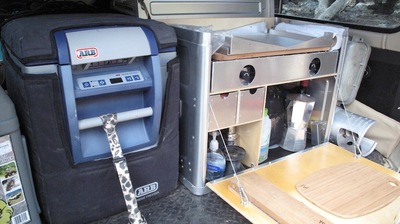 I was intimidated at first. Fully half again as large as my old box, the 19" x 25" x 15" Kanz is gleaming burnished aluminum with beautiful satin-finished Baltic birch. I could lift and carry the old box, but the Kanz takes two of us. This is because it is a kitchen, not just a chuck box; included with our kit is the 22" Partner Steel stove and Kanz's own complete cookware / utensil set. The box + stove is 36 pounds (40 with the Coleman dual-fuel), and 52 with cookware etc. (Kanz's set includes a top-line Snow Peak cookset, Kanz' own double-wall mugs, a percolator, enamelware, and flatware).
I was intimidated at first. Fully half again as large as my old box, the 19" x 25" x 15" Kanz is gleaming burnished aluminum with beautiful satin-finished Baltic birch. I could lift and carry the old box, but the Kanz takes two of us. This is because it is a kitchen, not just a chuck box; included with our kit is the 22" Partner Steel stove and Kanz's own complete cookware / utensil set. The box + stove is 36 pounds (40 with the Coleman dual-fuel), and 52 with cookware etc. (Kanz's set includes a top-line Snow Peak cookset, Kanz' own double-wall mugs, a percolator, enamelware, and flatware).
It is hard to come up with any engineering complaints about this kitchen. Designed over a 12-year period by industrial designer Harald Kanz, the kitchen is the embodiment of German meticulousness for detail and quality. As a young boy, Harald's imagination was captivated by stories of adventure and exploration, he’s said. Fascinated by how things work in the outdoors, he sketched his first tent designs and fire setups while on camping trips with his parents in Germany.
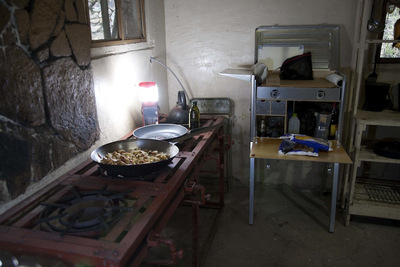 On a recent science expedition to the Sierra Madre in Mexico, we used the Kanz Field Kitchen to augment the very rudimentary kitchen at the old camp.The Kanz Kitchen’s easily detachable legs (fitted with clever pressure springs that you don’t have to fuss with, they just slide in and out easily but hold tight when they need to) perch the kitchen’s top surface at optimal working height (37"); the lid acts as windscreen, can be laid flat as a shelf (with optional hardware), or can detach as serving tray. A custom cutting board fits into the Partner stove, and the 2 drawers, which look deceptively small, swallow all necessary utensils plus 4 double-walled mugs (and, I found out happily, my Sea to Summit folding bucket). There is a 2" hole for the propane line right where it needs to be (with an included cap, which we’ve needed to seal up the kitchen against mice), and the whole unit can be ordered as
On a recent science expedition to the Sierra Madre in Mexico, we used the Kanz Field Kitchen to augment the very rudimentary kitchen at the old camp.The Kanz Kitchen’s easily detachable legs (fitted with clever pressure springs that you don’t have to fuss with, they just slide in and out easily but hold tight when they need to) perch the kitchen’s top surface at optimal working height (37"); the lid acts as windscreen, can be laid flat as a shelf (with optional hardware), or can detach as serving tray. A custom cutting board fits into the Partner stove, and the 2 drawers, which look deceptively small, swallow all necessary utensils plus 4 double-walled mugs (and, I found out happily, my Sea to Summit folding bucket). There is a 2" hole for the propane line right where it needs to be (with an included cap, which we’ve needed to seal up the kitchen against mice), and the whole unit can be ordered as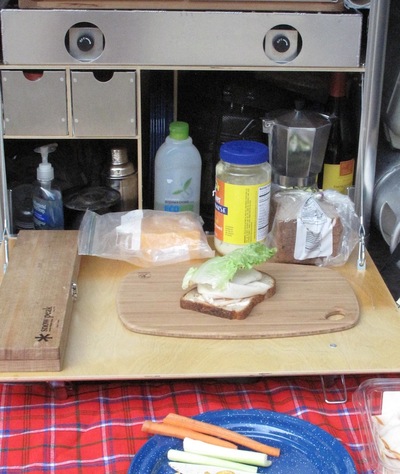 The drawers swallow all our utensils, coffee mugs, and even a folding Sea to Summit bucket. A full-sized cook kit from Snow Peak, an espresso maker, bottle of wine, dish soap, six plates, a full set of spices, coffee making filter, and martini shaker round out the kit, with room to spare. an optional certified-bear-safe unit. The 2 side shelves which are optional are very handy.
The drawers swallow all our utensils, coffee mugs, and even a folding Sea to Summit bucket. A full-sized cook kit from Snow Peak, an espresso maker, bottle of wine, dish soap, six plates, a full set of spices, coffee making filter, and martini shaker round out the kit, with room to spare. an optional certified-bear-safe unit. The 2 side shelves which are optional are very handy.
The only thing I found curiously lacking was a paper towel holder. A simple holder that would hang under a side shelf would be great. In keeping with Kanz’ environmentally aware design, perhaps this is by design—a gentle reminder I should be using washable towels instead, but I hate smelly kitchen towels when on camping trips.
I used the kitchen out of the back of the Land Cruiser, facing outwards, for fixing lunch on a recent science expedition into the Sierra Madre backcountry in Mexico. Sitting next to the ARB fridge, the top area was very convenient for setting things when they came out of the fridge, and the fold-down work surface perfect for making sandwiches.
For our camp, it’s easier to pull the kitchen out and use it on its legs, rather than on the tailgate. I like the longer legs, but the height of the stove makes it little harder to use big pots; it’s an adjustment to the usual tailgate-height or height of your at-home stove, but it’s do-able considering the convenience. We use the stove with our aluminum propane cylinder, the same one Kanz sells (he actually got the idea from Jonathan’s article on propane systems in Overland Journal). I have yet to put a mount into the back of my Land Cruiser for the cylinder, but I plan to (Kanz also sells this . . .).
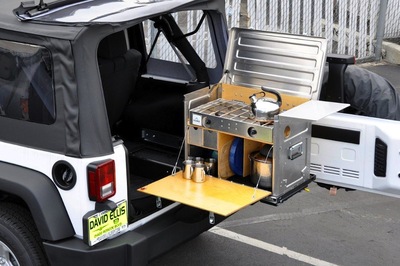 On Tembo Tusk's side-out slide.The Kanz Field Kitchen is large enough that, with the ARB fridge in the back of the Land Cruiser, it fills the back, with no room for our nice stainless steel water tank (we had to resort to using the Rhino plastic jug, the horror!). For ultimate convenience we are working on a layout that would allow us to mount the water tank as well as the fridge and Kanz Field Kitchen on pull-out runners, but we haven’t quite sorted it out.
On Tembo Tusk's side-out slide.The Kanz Field Kitchen is large enough that, with the ARB fridge in the back of the Land Cruiser, it fills the back, with no room for our nice stainless steel water tank (we had to resort to using the Rhino plastic jug, the horror!). For ultimate convenience we are working on a layout that would allow us to mount the water tank as well as the fridge and Kanz Field Kitchen on pull-out runners, but we haven’t quite sorted it out.
Kanz does sell Tembo Tusk's superb quality sliders (side-out or front-out) for the Field Kitchen. Though expensive and heavy, they are the best available and really add to the utility of the kitchen. 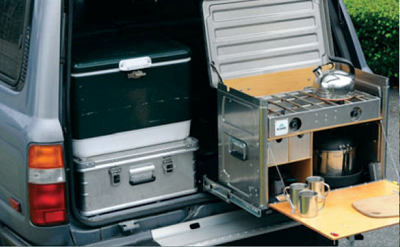 On Tembo Tusk's front-out slide.
On Tembo Tusk's front-out slide.
Kanz accessories include a matching pantry box and a bridge / work surface that joins the two. Thinking of everything (so German!), Kanz also sells wall mounts, a soft cover for transit-protection, and leather straps for horse outfitters.
They also sell my favorite food boxes: Zarges K470 aluminum cases (in photo at left, under the cooler), which are light and stack nicely. I currently use one for my own pantry, with a collapsible metal stand (an old Coleman stove stand), and it matches the Kanz Field Kitchen nicely.
I was ready to find the Kanz Kitchen lacking in comparison to my old dear ones, if only out of loyalty, but I could not: it’s a new classic, ready to fill the old shoes with honor. The price is, of course, daunting, and could be off-putting for some. But with absolute top-quality, made-in-America workmanship, exceptional materials, fit, and finish, it is worth every penny. A field kitchen is, after all, more than just a place to store your kitchen gear. With time and use, it will store many wonderful memories, of good times and beautiful places with special friends.
Specifications, Kanz Field Kitchen:
Outside Dimensions (H x W x D): 19.4 in x 25.4 in x 15.00 in, (492 mm x 645 mm x 381 mm)
Inside Dimensions of stove compartment (H x W x D): 6.3 in x 24.8 in x 14.0 in, (160 mm x 630 mm x 355 mm)
Inside Dimensions of silver ware drawer (H x W x D): 4.0 in x 3.8 in x 13.9 in, (100 mm x 97 mm x 353 mm)
Group size + guest: 6+2
Weight (empty): 25 lbs (12 kg)
Weight (with Partner Steel propane stove): 36 lbs (16.3 kg)
Weight (with Coleman 414 dual fuel stove): 40 lbs (18.1 kg)
Weight of optional cookware set): 16 lbs (7.3 kg)
Table top height (on long leg set): 26 in (660 mm)
Counter top height (long leg ; short leg set): 43 in (109 mm); 37 in (940 mm)
Transport: One foldable sprung handle on each side with rubber grip
Material: Baltic birch plywood riveted to marine grade aluminum panels
Finish: Polyurethane clear coat on wood panels inside and outside
Price without stove or cooking set: $595
Price as tested (with Partner Steel Stove and complete cooking set): $1399
Fit to be tied: Tie-down torture tests the metal of Expeditionware Transport Loops
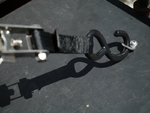 I’m never sure which alarms me more: a vehicle loaded with completely unsecured cargo and equipment, or one loaded with cargo and equipment secured poorly. After all, the former implies simple ignorance on the part of the owner, and ignorance can be overcome with education. But the latter implies some rudimentary level of awareness—and then a complete failure to do the simple arithmetic that will tell you what will happen to the 30-pound Hi-Lift jack bungeed to your front brush guard should you be, say, rear-ended at a stoplight. No, I am not making this up, and yes, I checked. Two neatly wound bungee cords comprised the total attachment of that jack to that brush guard. I’ve seen another Hi-Lift bungeed to a very well-constructed internal roll cage (talk about Manichaean reasoning), and uncounted tool boxes, fridges, and Pelican cases all held down by what are, let’s be frank, glorified rubber bands.
I’m never sure which alarms me more: a vehicle loaded with completely unsecured cargo and equipment, or one loaded with cargo and equipment secured poorly. After all, the former implies simple ignorance on the part of the owner, and ignorance can be overcome with education. But the latter implies some rudimentary level of awareness—and then a complete failure to do the simple arithmetic that will tell you what will happen to the 30-pound Hi-Lift jack bungeed to your front brush guard should you be, say, rear-ended at a stoplight. No, I am not making this up, and yes, I checked. Two neatly wound bungee cords comprised the total attachment of that jack to that brush guard. I’ve seen another Hi-Lift bungeed to a very well-constructed internal roll cage (talk about Manichaean reasoning), and uncounted tool boxes, fridges, and Pelican cases all held down by what are, let’s be frank, glorified rubber bands.
 I’m never sure which alarms me more: a vehicle loaded with completely unsecured cargo and equipment, or one loaded with cargo and equipment secured poorly. After all, the former implies simple ignorance on the part of the owner, and ignorance can be overcome with education. But the latter implies some rudimentary level of awareness—and then a complete failure to do the simple arithmetic that will tell you what will happen to the 30-pound Hi-Lift jack bungeed to your front brush guard should you be, say, rear-ended at a stoplight. No, I am not making this up, and yes, I checked. Two neatly wound bungee cords comprised the total attachment of that jack to that brush guard. I’ve seen another Hi-Lift bungeed to a very well-constructed internal roll cage (talk about Manichaean reasoning), and uncounted tool boxes, fridges, and Pelican cases all held down by what are, let’s be frank, glorified rubber bands.
I’m never sure which alarms me more: a vehicle loaded with completely unsecured cargo and equipment, or one loaded with cargo and equipment secured poorly. After all, the former implies simple ignorance on the part of the owner, and ignorance can be overcome with education. But the latter implies some rudimentary level of awareness—and then a complete failure to do the simple arithmetic that will tell you what will happen to the 30-pound Hi-Lift jack bungeed to your front brush guard should you be, say, rear-ended at a stoplight. No, I am not making this up, and yes, I checked. Two neatly wound bungee cords comprised the total attachment of that jack to that brush guard. I’ve seen another Hi-Lift bungeed to a very well-constructed internal roll cage (talk about Manichaean reasoning), and uncounted tool boxes, fridges, and Pelican cases all held down by what are, let’s be frank, glorified rubber bands.
Bungees have their uses, but heavy cargo in an overland vehicle should be secured with ratchet straps capable of withstanding the forces generated should you experience an unplanned encounter with Isaac Newton. Anything much heavier than a sleeping bag can cause injury or worse in an accident or rollover. (Come to think of it, I wouldn’t want to be clobbered by my 18-pound Butler sleeping bag . . .)
Decent ratchet straps are available at any hardware store. But very few, if any, vehicles come from the factory with tie-down points strong enough and numerous enough to anchor those straps. It’s almost always up to the owner to add proper loops or eye bolts. The conundrum of where to locate them is rarely solved permanently. A few items such as the fridge might have a more or less permanent location, but the distribution of other gear is subject to change, and to the addition of new gear. Bolt in too many tie-down loops and they can be almost as much a hindrance as a help to properly securing stuff. Adjustable rails such as those from Mac’s Custom Tie-Downs add versatility; the anchor plate systems from the same company, which leave only an unobtrusive rounded base when not needed, are useful as well. But both of these need a fair amount of space to install.
A few years ago, while looking for tie-down loops for the rear of my FJ40, I found the Ring Products Transit Loops at Expedition Exchange. The stainless-steel loops were originally designed to be attached to motorcycles to provide easily accessible points on which to hook tie-down straps when transporting the bike on the trailer or in a truck. Lightweight and unobtrusive, they obviated the need to loop cinch straps awkwardly around handlebars or luggage racks. However, with my FJ40 in mind, I realized they looked just the right size to bolt down on top of the join between the body tub and hardtop, using the numerous existing 10mm bolts.
Indeed, such proved the case, and a half dozen of the rings gave me a solid perimeter tie-down system. I added a few more on the wheel wells, then started looking at our other vehicles and realizing there were a nearly infinite number of places the little rings could be utilized to secure a nearly infinite number of items. They could be installed in very tight spaces, and needed only a single 1/4-inch hole to mount. Visually, a pair didn’t look like overkill when securing something as small as a pack of road flares (with a bungee—a proper use for one), but four of them would lock down an Engel immovably.
And then the company went out of business. Damn.
I moved on to other tie-down systems for other projects—but how I missed those versatile little rings.
The fellows at Expedition Exchange apparently shared my thoughts, because after trying in vain for years to track down the Ring Products company or principals, they decided they’d exercised due diligence—and had a leftover reproduced at a local machinist. Skimming the EE website a few months ago, I noticed the newly introduced Expeditionware Transport Loops. Woohoo! I immediately ordered some to look at, and found them to be apparently exact copies. Excellent.
However, as I examined the new loops I found myself, for the first time, wondering about the ultimate strength of such a compact fitting. I’d always assumed that, since four of the originals were designed to hold down a motorcycle during road transport, they were certainly strong enough to secure a fridge or a Pelican case full of tools. But now I was curious about their limits.
 With a loop in hand, I looked around our shop and carport for a way to put it to the test. I had neither a strain gauge nor a scale sufficient to register the several hundred pounds I assumed the loop would take before it failed. Bolt it to one of the steel roof beams in the carport and hang successive weights off it? Perhaps, but how to suspend 400—or 600 or 800—pounds in successive increments? Hook one between two Land Cruisers and try to pull it apart? But that wouldn’t tell us what the failure point was, and sounded like a procedure that would wind up either as an object lesson at the next Overland Expo, or a feature on YouTube.
With a loop in hand, I looked around our shop and carport for a way to put it to the test. I had neither a strain gauge nor a scale sufficient to register the several hundred pounds I assumed the loop would take before it failed. Bolt it to one of the steel roof beams in the carport and hang successive weights off it? Perhaps, but how to suspend 400—or 600 or 800—pounds in successive increments? Hook one between two Land Cruisers and try to pull it apart? But that wouldn’t tell us what the failure point was, and sounded like a procedure that would wind up either as an object lesson at the next Overland Expo, or a feature on YouTube.
But, hmm . . . the Land Cruiser. I looked at the rear bumper/tire carrier on the FJ40, specifically at the stout, one-inch-thick shackle mounts on either corner. Then I looked at the Hi-Lift jack nearby. That might do . . .
Using a grade 8 bolt and some graduated washers, I affixed the ring to the shackle mount via the smaller of its two holes. Then, with a steel quick-link connector through the larger hole, I attached the ring to the slot on the bottom of the Hi-Lift’s tongue, which I’d position just above the shackle mount.
Now I had a mechanism, but I still didn’t have a means of measuring the stress on the ring. Given that my FJ40 weighs a bit over 4,000 pounds, I decided rather arbitrarily that if I could lift one rear wheel off the ground—or even come reasonably close to doing so—the Expeditionware Transport Loop would have proved its mettle as far as I was concerned. I donned a heavy Carhart jacket, gloves, and safety glasses in case the ring exploded and flung bits of stainless steel hither and yon.
I began working the Hi-Lift’s handle and the loop took up strain. The assembly started to emit ominous metallic creakings, and for the first time I begin to wonder if this was a good idea. How could I expect a tiny ring a few millimeters thick to lift a corner of a 4WD vehicle?
 The bumper rose, and the right rear leaf spring started to flex. Now, if I peaked around the Hi-Lift’s main beam, which I was keeping between me and the poor little ring, I could see the latter flattening. Was there some stretching going on as well? The sidewall bulge came out of the right rear tire as the bumper continued to rise with each stroke of the jack handle, but it remained planted on the ground. Now I could clearly see the large hole in the Transit Loop elongating. More creaking, and a ping or two from somewhere in there.
The bumper rose, and the right rear leaf spring started to flex. Now, if I peaked around the Hi-Lift’s main beam, which I was keeping between me and the poor little ring, I could see the latter flattening. Was there some stretching going on as well? The sidewall bulge came out of the right rear tire as the bumper continued to rise with each stroke of the jack handle, but it remained planted on the ground. Now I could clearly see the large hole in the Transit Loop elongating. More creaking, and a ping or two from somewhere in there.
But then—the tire was a few millimeters off the ground. I could spin it with a boot. A single Transit Loop had successfully lifted the corner of an FJ40 off the ground—and one equipped with a massive Stout Equipment bumper/tire rack at that.
I have no way of knowing exactly how much strain the loop was withstanding at the end, but I’m certainly convinced that, employed in suitable numbers, the Expeditionware Transit Loops are more than up to the job of safely locking down the heaviest fridges, tool boxes, and equipment cases.
At nine bucks each you can afford to buy a bunch. I guarantee you’ll find uses for as many as you have.
Unless you’re still convinced a bungee or two will suffice. Expeditionware Transport Loops

Book review: Tom Sheppard’s Four-by-four Driving (revised 2nd edition)
 Quick: How many four-wheel-drive systems can you name off the top of your head? Let’s see. Just from Jeep we have Quadra-Trac and Command-Trac—oh, and Selec-Trac. And, um, Quadra-Drive, and Freedom-Drive. BMW has xDrive; Mercedes counters with 4Matic. Toyota has ActiveTrak; Nissan offers the rather unimaginatively labelled All-Mode 4WD. That’s just five manufacturers. How many four-wheel-drive systems can there possibly be? Read Tom Sheppard’s Four-by-four Driving and you’ll learn that, once the marketing hype is peeled away, there are basically just three (with one arguable exception—you’ll have to read the book to find out which). The profusion of trademarked drivetrains are all just slightly tweaked variations on a trio of themes.
Quick: How many four-wheel-drive systems can you name off the top of your head? Let’s see. Just from Jeep we have Quadra-Trac and Command-Trac—oh, and Selec-Trac. And, um, Quadra-Drive, and Freedom-Drive. BMW has xDrive; Mercedes counters with 4Matic. Toyota has ActiveTrak; Nissan offers the rather unimaginatively labelled All-Mode 4WD. That’s just five manufacturers. How many four-wheel-drive systems can there possibly be? Read Tom Sheppard’s Four-by-four Driving and you’ll learn that, once the marketing hype is peeled away, there are basically just three (with one arguable exception—you’ll have to read the book to find out which). The profusion of trademarked drivetrains are all just slightly tweaked variations on a trio of themes.
 Quick: How many four-wheel-drive systems can you name off the top of your head? Let’s see. Just from Jeep we have Quadra-Trac and Command-Trac—oh, and Selec-Trac. And, um, Quadra-Drive, and Freedom-Drive. BMW has xDrive; Mercedes counters with 4Matic. Toyota has ActiveTrak; Nissan offers the rather unimaginatively labelled All-Mode 4WD. That’s just five manufacturers. How many four-wheel-drive systems can there possibly be? Read Tom Sheppard’s Four-by-four Driving and you’ll learn that, once the marketing hype is peeled away, there are basically just three (with one arguable exception—you’ll have to read the book to find out which). The profusion of trademarked drivetrains are all just slightly tweaked variations on a trio of themes.
Quick: How many four-wheel-drive systems can you name off the top of your head? Let’s see. Just from Jeep we have Quadra-Trac and Command-Trac—oh, and Selec-Trac. And, um, Quadra-Drive, and Freedom-Drive. BMW has xDrive; Mercedes counters with 4Matic. Toyota has ActiveTrak; Nissan offers the rather unimaginatively labelled All-Mode 4WD. That’s just five manufacturers. How many four-wheel-drive systems can there possibly be? Read Tom Sheppard’s Four-by-four Driving and you’ll learn that, once the marketing hype is peeled away, there are basically just three (with one arguable exception—you’ll have to read the book to find out which). The profusion of trademarked drivetrains are all just slightly tweaked variations on a trio of themes.
Few people on earth can boast the expedition travel experience of Tom Sheppard, starting a decade before he led the 1975 Joint Services Expedition west-east crossing of the Sahara, and leading to more recent explorations of the most remote corners of Algeria. Since the vast majority of Tom’s journeys have been accomplished via a solo vehicle—with himself frequently the sole participant—you can bet his expertise in four-wheel-drive technique and equipment reflects the utmost attention to detail, an attention that recognizes the dire consequences of becoming irretrievably stuck 150 miles off-tracks in the Sahara. It’s likely no one short of a test pilot delves as thoroughly into the minutiae of his craft—and Tom Sheppard was a test pilot before he took up earth-bound journeying.
 Click to enlargeFour-by-four Driving is frequently assumed to be a condensed version of Sheppard’s legendary Vehicle-Dependent Expedition Guide; in fact it is an almost entirely different book, and should be considered a prerequisite to the latter. Four-by-four Driving teaches you what you need to know—in terms of vehicle systems and driving skills—to fully exploit the awesome depth of expedition travel expertise contained in VDEG.
Click to enlargeFour-by-four Driving is frequently assumed to be a condensed version of Sheppard’s legendary Vehicle-Dependent Expedition Guide; in fact it is an almost entirely different book, and should be considered a prerequisite to the latter. Four-by-four Driving teaches you what you need to know—in terms of vehicle systems and driving skills—to fully exploit the awesome depth of expedition travel expertise contained in VDEG.
Four-by-four Driving reads less as text than as though Tom were an earnest but personable professor—or squadron leader—talking to you from the front of a classroom, pointer whacking diagrams on a flip-chart. And, as in a class, you’re expected to pay attention. Try to read section 2.3 without first reading section 2.1 and you’ll not only wind up confused, you’ll be parenthetically reminded of the material you should have already covered. If Four-by-four Driving were less engagingly written the depth of explication could have tipped over into pedantry, but, inevitably, just at the moment your eyes begin to cross with the details of, say, electronic differential locks, the following section will be titled something such as We have ways of making you torque, and you smile and dive back in.
A bit less than the first third of Four-by-four Driving covers four-wheel-drive systems (and this is where much of the current edition’s revisions necessarily reside). The next fat third discusses driving techniques and recovery, and here Tom’s huge experience shines, especially regarding his overriding mantra of mechanical sympathy—the constant awareness of the vehicle’s strengths and limitations, vital to ensure one not only makes it through difficult terrain, but all the way back home. This section alone is worth the cost of the book, and even if you consider yourself an expert driver, I guarantee you’ll learn something. The last third, titled Expedition basics, is just that—an introduction into material covered in much more depth in VDEG.
 Click to enlargeIt feels monstrously presumptuous to point out shortcomings in any work by a man whose books are the bibles of overlanders the world over, but a book review without critique would be simply an ad. There are a few quibbles, albeit mostly due simply to limited space. The section on winching, for example, is (as stated right up front by the author) brief in the extreme, and inadequate as anything but familiarization in preparation for finding real instruction. The discussion doesn’t even mention synthetic winch line, which could fairly be considered a revolution in the application of the equipment. Similarly, the Hi-Lift jack, an expedition mainstay, merits barely a paragraph—and the photo of one in use shows the operating handle positioned ideally to cleave the skull of the user from the chin up should he lose his grip.
Click to enlargeIt feels monstrously presumptuous to point out shortcomings in any work by a man whose books are the bibles of overlanders the world over, but a book review without critique would be simply an ad. There are a few quibbles, albeit mostly due simply to limited space. The section on winching, for example, is (as stated right up front by the author) brief in the extreme, and inadequate as anything but familiarization in preparation for finding real instruction. The discussion doesn’t even mention synthetic winch line, which could fairly be considered a revolution in the application of the equipment. Similarly, the Hi-Lift jack, an expedition mainstay, merits barely a paragraph—and the photo of one in use shows the operating handle positioned ideally to cleave the skull of the user from the chin up should he lose his grip.
As far as I can tell reading back through my jealously hoarded collection of Sheppard’s articles (which date to a 1984 Car magazine piece testing a new 110 pickup in Algeria), he has rarely if ever equipped his vehicles with either a winch or a Hi-Lift, so perhaps this brevity is simply Tom’s own nod to his lack of complete intimacy with the devices. (On the other hand, I still plan to someday slavishly copy his cunning bespoke wheel claw adaptor, which allows easy raising of one tire out of deep sand using a simple bottle jack.)
Tom includes an comprehensive section (8.2) on tires and tire selection; however, I would like to have seen a primer on repairing tubeless tires with plugs—an easy and fast method to get back under way after experiencing what is by far the most common cause of breakdown. Also, Tom still seems to be under the impression that it takes a big, fast volume of air to reseat the bead on a tubeless tire. I’ve successfully accomplished it with very small compressors.
Okay, duty done—I’ve critiqued. The simple fact is, whether you’re an accomplished overlander or have just moved from your Corolla into a Land Cruiser and are wondering what that extra gear lever does, Four-by-four Driving is an absolutely essential volume for any expedition library—as well as a delightful glimpse into the persona of one of the overlanding world’s legends. You can order it directly from its author at Desert Winds Publishing, here: Desert Winds Publishing
How do I find information for shipping a bike or vehicle overseas?
What are some resources for someone wanting to ship a Jeep overseas, such as China or Australia?
- David T., USA (via email)
Long Term Review: First Gear Monarch motorcycling jacket and Escape pants for women
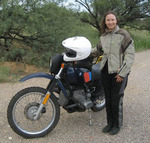 A couple of years ago I conducted an extensive review of armored motorcycling jackets suitable for touring and off-pavement riding. The selection ranged from a budget, Chinese-made, $300 offering from Fieldsheer to an outrageously exquisite $1,300 Rukka from Finland, presumably sewn by organically grown virgins in Helsinki.
A couple of years ago I conducted an extensive review of armored motorcycling jackets suitable for touring and off-pavement riding. The selection ranged from a budget, Chinese-made, $300 offering from Fieldsheer to an outrageously exquisite $1,300 Rukka from Finland, presumably sewn by organically grown virgins in Helsinki.
A bit up from the bottom of the pack pricewise was a First Gear Rainier, a $400 jacket made in Vietnam. It stood out in value with its combination of good quality and looks, comfortable armor, and effective waterproofing. Based on those initial impressions, Roseann decided to order a women’s Monarch jacket and Escape pants from the company. She’s now had two years and two motorcycles worth of time wearing the set, and we decided to do a long-term update.
 A couple of years ago I conducted an extensive review of armored motorcycling jackets suitable for touring and off-pavement riding. The selection ranged from a budget, Chinese-made, $300 offering from Fieldsheer to an outrageously exquisite $1,300 Rukka from Finland, presumably sewn by organically grown virgins in Helsinki.
A couple of years ago I conducted an extensive review of armored motorcycling jackets suitable for touring and off-pavement riding. The selection ranged from a budget, Chinese-made, $300 offering from Fieldsheer to an outrageously exquisite $1,300 Rukka from Finland, presumably sewn by organically grown virgins in Helsinki.
A bit up from the bottom of the pack pricewise was a First Gear Rainier, a $400 jacket made in Vietnam. It stood out in value with its combination of good quality and looks, comfortable armor, and effective waterproofing. Based on those initial impressions, Roseann decided to order a women’s Monarch jacket and Escape pants from the company. She’s now had two years and two motorcycles worth of time wearing the set, and we decided to do a long-term update.
An adventure-motorcycling jacket must strive to combine several features that are mutually exclusive. It must be warm in cold weather and cool in hot weather. It must be able to resist not just rain, but rain driven at 60mph or more, while allowing flow-through ventilation in sunny conditions. It must protect the wearer against abrasion and impact forces in a laydown on a trail or a more serious accident on pavement, while retaining freedom of movement and comfort, and avoiding bulk. Finally, it’s nice if the package looks good.
Obviously no jacket combines all these features perfectly. A Motoport Ultra II jacket in that first test boasted unequalled crash protection, but was so bulky that, as I mentioned at the time after looking in a mirror at my bloated profile, “Entomologists will think you’re pupating.”
On the other end of the fashion scale was the legendary waxed-cotton Barbour International, which lends anyone who dons it a rakish hint of Steve McQueen but which lacks any armor whatsoever. So picking a motorcycling jacket is a matter of deciding on one’s own priorities, up to and including style, while also keeping in mind keeping one’s mortality and fragile, evolutionarily compromised anatomy.
I was leery about including First Gear at the time of that review, since the company had been through several changes of ownership. But the current management, motorcycle equipment distributors Tucker Rocky, apparently had cracked the whip and gotten a handle on quality control. Roseann’s experience seems to confirm that—her jacket and pants have held up well, showing no fraying stitching, failing DWR (durable water-repellent) coating on the exterior, or even pilling on the fleece neck lining. Only the slightest wear on the inside of the knit cuffs is apparent.
In terms of performance, the rundown she gave me while I took notes adds up to a grade of about a solid B.
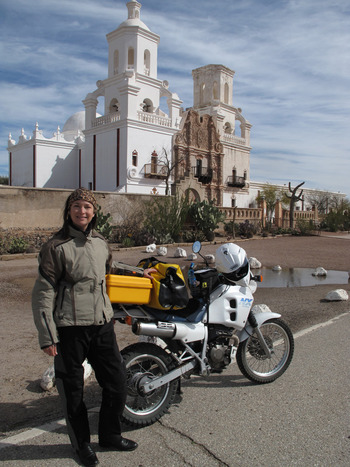 The Monarch and Escape on its first tour, two years ago, during a March southern Arizona dirt-and-pavement weekend.First, she noted that the jacket really does seem to be cut for women in the shoulders, arms, and torso; it’s not merely a men’s small masquerading as gender-specific.
The Monarch and Escape on its first tour, two years ago, during a March southern Arizona dirt-and-pavement weekend.First, she noted that the jacket really does seem to be cut for women in the shoulders, arms, and torso; it’s not merely a men’s small masquerading as gender-specific.
Significantly, she mentioned that she’s able to forget the Knox CE-rated shoulder and elbow armor while riding; some armored jackets I’ve worn (such as that Motoport) never let you do so. Her only note was that the jacket’s arms fit somewhat loosely on her 115-pound frame even with the two Velcro cinch straps pulled all the way tight, resulting in some flapping at speeds over 110 mph. I think she was kidding about that last bit.
The pants, while also very comfortable around their armored hips, weren’t quite so forgettable in the knees: When in a normal riding position, Roseann found she needed to slightly hitch up each leg to arrange the knee armor comfortably on top of her knee rather than binding below it. This might be a personal fit issue, but it points out the importance of trying on armored cycling clothing before buying it if possible. Fortunately the knee issue is a small and correctable one.
Roseann rated ventilation in the Monarch as “adequate.” A seven-inch zippered vent in front of each shoulder lets in the breeze; corresponding vents in back let it out again. Small vents behind each sleeve add a bit of air movement up the arms. Considering Roseann’s Arizona-native tolerance for heat and preference for riding in the desert summer, I’d guess her “adequate” means ventilation in the Monarch could be slightly better.
There are two approaches to the conundrum of rain protection versus ventilation in motorcycling jackets. One is to make an outer armored jacket of breathable or even mesh material, and employ a separate inner waterproof (and frequently insulated) shell for dryness. This works well for mostly dry environments, but the waterlogged outer shell can become annoying if 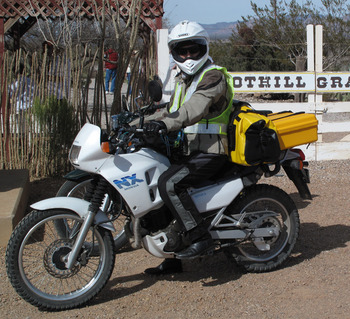 Lacking sufficient reflective tape, Roseann opts to wear a safety vest when riding pavement; the pants' knee pads are a little low, and have to be manually adjusted each time the bike is mounted.experienced too frequently.
Lacking sufficient reflective tape, Roseann opts to wear a safety vest when riding pavement; the pants' knee pads are a little low, and have to be manually adjusted each time the bike is mounted.experienced too frequently.
The other approach is to make the outer shell waterproof, and ventilate it as well as possible with covered or waterproof zippers. The latter is the approach First Gear took; the Monarch is waterproofed with an interior coating of minimally breathable polyurethane (dubbed “Hypertex”) and an outer DWR coating.
Nevertheless, the company includes an inner shell incorporating a three-layer waterproof laminate (and a fleece lining). The outer jacket on its own has proven completely rain-tight so far. The inner jacket is stylish enough to be worn on its own, a good addition to kit for long journeys where you might need a jacket for visiting museums or restaurants.
With nary a spill to her credit, Roseann is in no position to rate the crash effectiveness of the Monarch and Escape. On paper, however, the specs look good. Both jacket and pants are sewn from 600-denier nylon, a step above the 500-denier fabric generally accepted as the minimum for adequate abrasion resistance. Kevlar underlay at knees, shoulders, and elbows should help prevent fabric tearing in an accident (Kevlar fibers resist shearing but, surprisingly, nylon is more abrasion-resistant). The CE-rated (Conformité Européenne) shock-absorbing armor is generously sized in the same three areas; a simpler closed-cell-foam pad adds some protection on the back.
On details and convenience, Roseann had nothing but praise. Pockets on both jacket and pants are plentiful, easy to access, and well-sealed with storm flaps or YKK water-resistant zippers. An MP3/phone pocket is completely protected inside. Jacket and pants zip together, enhancing both draft protection and safety in a fall and slide on pavement (when an unsecured jacket can ride up and expose skin).
All in all, Roseann’s experience with the Monarch and Escape seems to have reinforced the favorable impression my brief time with the Rainier left with me. First Gear has produced an affordable, yet comfortable and protective set of outerwear that should hold up well to extended riding.
Even if it’s not sewn by organically grown virgins in Helsinki.
* * * * * * * * * * *
First Gear Monarch Jacket, msrp $470 (5-year warranty, 2-year crash protection policy). Three colors, sizes XS-XXL. Men's equivalent: Teton Jacket. Now includes LED light that clips on back.
First Gear Escape Pant, msrp $380 (5-year warranty, 2-year crash protection policy). Black, sizes 6-18. Also in Men's. Now includes inner liner pant.
A home in the bed of your truck: Four Wheel Campers
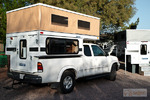 FWC has been an OX sponsor since the beginning.
FWC has been an OX sponsor since the beginning.
Over the years, we have been through a lot of vehicle-based camping setups, beginning with a couple of sleeping bags rolled out on the roof rack of my FJ40. We’ve gone minimalist with backpacking tents and stoves, luxurious with family-sized cabin tents and padded cots. We’ve tried roof tents, trailers, truck-bed mattresses. For some time we owned a WilderNest, a pickup shell with a cunning roof that flipped sideways to turn into a bed, with an enormous tent erected semi-automatically above it. I remember spending a mostly sleepless night trying to brace the frame of that spinnaker-like tent in a 40mph Sea of Cortez Norte. It was never quite the same afterward. Of all the setups that have come and gone, the one about which we wax most nostalgic is our Four Wheel Camper. Mounted first on a 1990 4WD Toyota pickup powered by a willing but overmatched 22RE four-cylinder, then on a 2000 4WD Tacoma with the 3.4-liter six (60 percent more power and better gas mileage), we put over 150,000 miles on that camper, using it as a mobile base for dozens of freelance magazine assignments and several books.
 FWC has been an OX sponsor since the beginning.
FWC has been an OX sponsor since the beginning.
Over the years, we have been through a lot of vehicle-based camping setups, beginning with a couple of sleeping bags rolled out on the roof rack of my FJ40. We’ve gone minimalist with backpacking tents and stoves, luxurious with family-sized cabin tents and padded cots. We’ve tried roof tents, trailers, truck-bed mattresses. For some time we owned a WilderNest, a pickup shell with a cunning roof that flipped sideways to turn into a bed, with an enormous tent erected semi-automatically above it. I remember spending a mostly sleepless night trying to brace the frame of that spinnaker-like tent in a 40mph Sea of Cortez Norte. It was never quite the same afterward. Of all the setups that have come and gone, the one about which we wax most nostalgic is our Four Wheel Camper. Mounted first on a 1990 4WD Toyota pickup powered by a willing but overmatched 22RE four-cylinder, then on a 2000 4WD Tacoma with the 3.4-liter six (60 percent more power and better gas mileage), we put over 150,000 miles on that camper, using it as a mobile base for dozens of freelance magazine assignments and several books.
At the time, we lived on a wildlife refuge seven miles down a rough dirt road, so even driving to town for groceries gave the rig a workout. Nevertheless, the sum total of my repairs to that camper was a rebuild of the door, which had begun to sag and needed reinforcing.
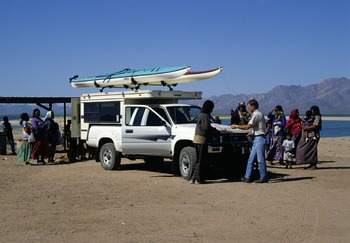 Our FWC in the 1990s, Punta Chueca, Sonora, Mexico, visiting Seri Indian country.We loved the FWC’s 30-second transformation into a full-standing-headroom camper with queen-sized bed, fridge, sink, and stove, and a comfortable settee. Sit-down snack at a rest stop on a highway trip? Easy. A couple of years into ownership, we experienced another Sea of Cortez Norte more furious than the first—and slept like babes. The pop-up roof didn’t even quiver. Despite the comfort and strength, the camper’s relatively feathery, aluminum-framed 700 pounds barely taxed the truck, and never kept us from reaching secluded backcountry hideouts.
Our FWC in the 1990s, Punta Chueca, Sonora, Mexico, visiting Seri Indian country.We loved the FWC’s 30-second transformation into a full-standing-headroom camper with queen-sized bed, fridge, sink, and stove, and a comfortable settee. Sit-down snack at a rest stop on a highway trip? Easy. A couple of years into ownership, we experienced another Sea of Cortez Norte more furious than the first—and slept like babes. The pop-up roof didn’t even quiver. Despite the comfort and strength, the camper’s relatively feathery, aluminum-framed 700 pounds barely taxed the truck, and never kept us from reaching secluded backcountry hideouts.
Gripes? Sure, we had a few. The water tank was too small and mounted too high. The main cabinet doors were flimsy sliding panels of 1/8th-inch plywood. And the three-way fridge gave up even slightly cooling its contents in any ambients over 90ºF. But they were tiny gripes compared to the consummate ease of pulling into a camp spot and having a home ready in less than a minute.
I write this up front so you don’t think what follows is some slavish encomium concocted in trade for sponsorship or ad revenue: We developed our enthusiasm for Four Wheel Campers the old-fashioned way—at full retail. So we jumped at the chance to make a second pilgrimage to the factory in Woodland, California, to visit with owners Tom and Celeste Hanagan, who’ve become good friends over the years. (Alas, this time we weren’t there to pick up a new camper.)
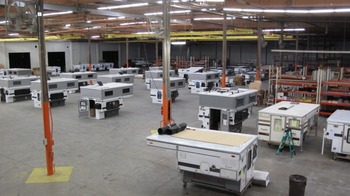 New factory floor in Woodland, CA. Older models belonging to customers, in for modifications or repairs after accidents, are in the lower right.Actually, it’s a different factory, significantly larger than the old one. A good thing, it seemed, because the space was clearly being utilized to the fullest already. A triple row of campers, aligned as if by laser, stood waiting for successive construction steps, from welding of the bare, elegant aluminum frame to final touches in flooring and lighting. There’s now more room for the ancillary shops such as upholstery and carpentry, which were formerly wedged into corners.
New factory floor in Woodland, CA. Older models belonging to customers, in for modifications or repairs after accidents, are in the lower right.Actually, it’s a different factory, significantly larger than the old one. A good thing, it seemed, because the space was clearly being utilized to the fullest already. A triple row of campers, aligned as if by laser, stood waiting for successive construction steps, from welding of the bare, elegant aluminum frame to final touches in flooring and lighting. There’s now more room for the ancillary shops such as upholstery and carpentry, which were formerly wedged into corners.
Most interestingly, I got an inside look—literally—at the evolution of the Four Wheel Camper under Tom and Celeste’s guidance. The small, high-mounted water tank I mentioned on ours? It’s been nearly doubled in size (now 22 gallons) and moved to the floor under a settee at the front of the camper, perfect for weight distribution. The cabinets now have proper hinged doors. The fridge option now includes a compressor-driven unit guaranteed not to go on strike in summer. And the corners of the main entrance door have been radiused to add significant rigidity.
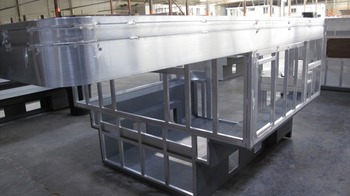 The amazing aluminum frame, a work of art.There was more. The roof—which on ours comprised three sections, yet never leaked despite the fact that I through-drilled it to mount racks for our sea kayaks—is now a one-piece, screw-free aluminum sheet that can’t leak. Much of the interior plywood is now superb multi-laminate European birch; exterior insulation is now rigid foam rather than fiberglass. Appliances have been upgraded, headroom augmented without changing the travel profile, the dining table is now a portable unit that can be used outside—nothing seemed to have escaped scrutiny and improvement.
The amazing aluminum frame, a work of art.There was more. The roof—which on ours comprised three sections, yet never leaked despite the fact that I through-drilled it to mount racks for our sea kayaks—is now a one-piece, screw-free aluminum sheet that can’t leak. Much of the interior plywood is now superb multi-laminate European birch; exterior insulation is now rigid foam rather than fiberglass. Appliances have been upgraded, headroom augmented without changing the travel profile, the dining table is now a portable unit that can be used outside—nothing seemed to have escaped scrutiny and improvement.
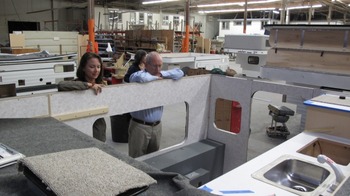 Tom and Roseann looking at an interior under construction.A lot of those improvement can even be applied to older Four Wheel Campers. In a corner of the factory was a cluster of customer-owned campers in various stages of repair and renewal. One vintage model at least 20 years old was receiving a new one-piece roof; others were having skins, water tanks, upholstery, or appliances replaced and updated. It was a reminder that a Four Wheel Camper is a genuine investment—as if prices on the used market weren’t reminder enough. We sold ours (to pay off our land) for 85 percent of what we paid for it new, despite all the use and mileage.
Tom and Roseann looking at an interior under construction.A lot of those improvement can even be applied to older Four Wheel Campers. In a corner of the factory was a cluster of customer-owned campers in various stages of repair and renewal. One vintage model at least 20 years old was receiving a new one-piece roof; others were having skins, water tanks, upholstery, or appliances replaced and updated. It was a reminder that a Four Wheel Camper is a genuine investment—as if prices on the used market weren’t reminder enough. We sold ours (to pay off our land) for 85 percent of what we paid for it new, despite all the use and mileage.
Ack. I just reminded myself that we sold it. Take my advice: If you buy one, keep it. Who needs land if you have a home on wheels?
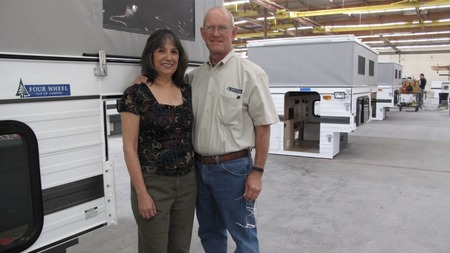 Tom and Celeste Hanagan, the power duo behind the quality and success of Four Wheel Campers.
Tom and Celeste Hanagan, the power duo behind the quality and success of Four Wheel Campers.
Do I really need a winch?
 Recently my friend Sergio Mendez Santiago emailed me from Puerto Vallarta, Mexico, where he and his wife, Ruth, are putting the finishing touches on their new Mitsubishi Triton, a fine turbodiesel-powered 4WD pickup (sadly unavailable in the U.S.). Like so many of us setting up a new vehicle, Sergio has been vacillating on the decision of whether or not to install a winch. We both thought it would be a good subject to explore. Since I have a Warn 8274 on my FJ40, and I installed a Warn M8000 on Roseann’s FJ60, I certainly appreciate their value (and I think my objectivity is on solid ground)—however, I certainly don’t think one absolutely needs a winch to be able to undertake even ambitious journeys.
Recently my friend Sergio Mendez Santiago emailed me from Puerto Vallarta, Mexico, where he and his wife, Ruth, are putting the finishing touches on their new Mitsubishi Triton, a fine turbodiesel-powered 4WD pickup (sadly unavailable in the U.S.). Like so many of us setting up a new vehicle, Sergio has been vacillating on the decision of whether or not to install a winch. We both thought it would be a good subject to explore. Since I have a Warn 8274 on my FJ40, and I installed a Warn M8000 on Roseann’s FJ60, I certainly appreciate their value (and I think my objectivity is on solid ground)—however, I certainly don’t think one absolutely needs a winch to be able to undertake even ambitious journeys.
 Recently my friend Sergio Mendez Santiago emailed me from Puerto Vallarta, Mexico, where he and his wife, Ruth, are putting the finishing touches on their new Mitsubishi Triton, a fine turbodiesel-powered 4WD pickup (sadly unavailable in the U.S.). Like so many of us setting up a new vehicle, Sergio has been vacillating on the decision of whether or not to install a winch. We both thought it would be a good subject to explore. Since I have a Warn 8274 on my FJ40, and I installed a Warn M8000 on Roseann’s FJ60, I certainly appreciate their value (and I think my objectivity is on solid ground)—however, I certainly don’t think one absolutely needs a winch to be able to undertake even ambitious journeys.
Recently my friend Sergio Mendez Santiago emailed me from Puerto Vallarta, Mexico, where he and his wife, Ruth, are putting the finishing touches on their new Mitsubishi Triton, a fine turbodiesel-powered 4WD pickup (sadly unavailable in the U.S.). Like so many of us setting up a new vehicle, Sergio has been vacillating on the decision of whether or not to install a winch. We both thought it would be a good subject to explore. Since I have a Warn 8274 on my FJ40, and I installed a Warn M8000 on Roseann’s FJ60, I certainly appreciate their value (and I think my objectivity is on solid ground)—however, I certainly don’t think one absolutely needs a winch to be able to undertake even ambitious journeys.
No matter what vehicle you drive, from a two-wheel-drive pickup with street tires to a Jeep Rubicon on BFG Mud-Terrains with diff locks front and rear, a 4:1 transfer case, disconnecting sway bar, etc. etc, you’re going to find yourself in situations for which a judgement call is needed. Obviously the two-wheel-drive pickup will have a much, much lower threshold at which discretion should kick in and you turn around, but the Rubicon will have its own threshold, beyond which you stand a good chance of getting stuck.
In such cases, a winch can give you the leeway to push the threshold, a little or a lot depending on several factors:
- Are you with other vehicles that can serve as anchor points for the winch line, or which are equipped with winches themselves?
- If you are traveling solo, are there natural anchor points, such as substantial trees, within reach of your winch line? If not, would it be possible to rig an anchor, such as by burying a spare wheel in sand?
- If the vehicle becomes immobilized, will the situation be immediately hazardous to occupants or the vehicle itself? Examples would be getting stuck in an off-camber situation next to a drop-off, or in beach sand below the high tide line.
- If you are traveling solo, and for some reason cannot self-recover even with the winch, are you a three-hour walk from help, or a three-day trek from civilization?
 A winch also provides insurance for situations when you’re simply caught unaware and find yourself stuck—a seemingly firm dry lake bed that suddenly gives way, an innocuous patch of snow that reveals itself as tractionless ice. If you travel solo frequently, and far off the beaten track, a winch offers substantial peace of mind even if you’re not prone to pushing the envelope. And of course with a winch you can assist others, although few people are willing to spend the money solely to be able to act as a good Samaritan.
A winch also provides insurance for situations when you’re simply caught unaware and find yourself stuck—a seemingly firm dry lake bed that suddenly gives way, an innocuous patch of snow that reveals itself as tractionless ice. If you travel solo frequently, and far off the beaten track, a winch offers substantial peace of mind even if you’re not prone to pushing the envelope. And of course with a winch you can assist others, although few people are willing to spend the money solely to be able to act as a good Samaritan.
Speaking of money: There’s more to buying a winch than buying a winch. You’ll need a rock-solid bumper designed to accommodate the winch you’ve chosen. You’ll also need a full recovery kit, including a tree-protector strap, at least two properly rated shackles, a snatch block, a winch-line damper, gloves, and preferably a winch line extension. I strongly recommend replacing the steel winch cable that comes with most winches with a synthetic line, which is far lighter and safer—and more expensive. Even with that weight savings, you’ll probably need to beef up your front suspension to properly handle the mass suddenly placed far out on the front of the vehicle. Finally, you’ll need a heavy-duty battery and charging system in the vehicle—preferably a dual-battery system in case of failure of the primary battery.
Add up everything and you can figure on tripling the cost of a moderately priced winch by the time you’re finished. (Speaking of which, I urge staying away from the cut-price Chinese clones of Warn and Ramsey winches, for reasons of both quality and ethics.)
 Learning about winches and winch lines at OX10.Oh, one more thing: A winch is fully capable of maiming or killing its operator or nearby spectators. So if you do install one, you are obligated to learn its proper and safe use.
Learning about winches and winch lines at OX10.Oh, one more thing: A winch is fully capable of maiming or killing its operator or nearby spectators. So if you do install one, you are obligated to learn its proper and safe use.
Given the significant expense, the significant associated modifications, and the learning curve, it’s tempting—and a perfectly reasonable strategy—to simply do without the winch; to use prudence when faced with questionable situations, and to make sure you have alternate methods for self-recovery.
To start with, a high-quality air compressor will enable you to properly reduce tire pressure when needed. Obviously you don’t need a compressor at all to lower tire pressure, but if all you have with you is an inexpensive compressor that takes a half-hour to inflate them again, you’re much less likely to air down when it’s called for. Very frequently, if a vehicle becomes stuck in soft sand, all that’s needed to get underway again is to reduce tire pressure to one bar (around 14 psi) or even a little lower.

Some people swear by sand mats, others spurn them, still others seem to view them as a necessary overland fashion accessory. The lightweight aluminum replacements for the old surplus steel PSP are much easier to manage, as are even newer plastic designs such as the Maxtrax. But sand mats are still a bulky, mostly single-purpose tool. You must make up your own mind if the terrain you explore makes them worth carrying.
 Sand mats, like these plastic ones from MaxTrax, are another good addition to your kit.Another love-it-or-hate-it tool is the exhaust jack, essentially a giant heavy-duty balloon you inflate with the vehicle’s exhaust. An exhaust jack can lift one side of a vehicle clear of even clingy muck. However, I’ve witnessed more failures of these things than makes me comfortable, from incompatible exhaust pipes to failed blow-off valves. Here’s an example from LROTV:
Sand mats, like these plastic ones from MaxTrax, are another good addition to your kit.Another love-it-or-hate-it tool is the exhaust jack, essentially a giant heavy-duty balloon you inflate with the vehicle’s exhaust. An exhaust jack can lift one side of a vehicle clear of even clingy muck. However, I’ve witnessed more failures of these things than makes me comfortable, from incompatible exhaust pipes to failed blow-off valves. Here’s an example from LROTV:
Put me in the hate-it camp.
Finally, of course, there’s the Hi-Lift jack, the tool everyone loves to hate. Awesomely versatile, fond of jamming, and dangerous if used incorrectly, the Hi-Lift can do everything up to and including winching—if you’re careful.
I think one of the best uses for the Hi-Lift is as a “casting” jack. Sometimes when a vehicle is stuck in a rut, the only thing needed to regain traction is to move it sideways out of the rut. In such a situation, you can jack up one end of the vehicle until the tires are clear, then simply shove the vehicle sideways off the jack and on to firmer ground. It sounds and looks quite alarming, but is perfectly safe if done carefully. This was the first thing I was taught to do with a Hi-Lift, but the technique seems to have been mostly lost.
A Hi-Lift can be used to lift buried tires out of sand in order to insert sand mats, but you’re wasting effort if you lift the body of the vehicle and have to overcome suspension droop. Better to use the optional fitting made to hook onto a wheel; then your efforts will produce immediate results.
Winching with the Hi-Lift is glacially slow, and requires a fair amount of chain and other accoutrements—but it works, and its very slowness gives you time to think and avoid unsafe moves. There are several kits made to turn the Hi-Lift into a winch; this video is about the most succinct I’ve seen on the actual process:
So there’s my stance. A winch is a valuable accessory, but I would never let the lack of one stop me from exploring—in fact my FJ40 had no winch for the first 20 years I owned it, including all the time I was guiding other vehicles into remote beaches in Mexico, and towing a trailer full of sea kayaks. If you wonder whether it’s possible to accomplish higher-level expedition travel without a winch, I give you Tom Sheppard, who has soloed 100,000 miles of the Sahara in a succession of Land Rovers and a Mercedes G-Wagen—not one of them burdened with a winch.
Hint: When using “Search,” if nothing comes up, reload the page, this usually works. Also, our “Comment” button is on strike thanks to Squarespace, which is proving to be difficult to use! Please email me with comments!
Overland Tech & Travel brings you in-depth overland equipment tests, reviews, news, travel tips, & stories from the best overlanding experts on the planet. Follow or subscribe (below) to keep up to date.
Have a question for Jonathan? Send him an email [click here].
SUBSCRIBE
CLICK HERE to subscribe to Jonathan’s email list; we send once or twice a month, usually Sunday morning for your weekend reading pleasure.
Overland Tech and Travel is curated by Jonathan Hanson, co-founder and former co-owner of the Overland Expo. Jonathan segued from a misspent youth almost directly into a misspent adulthood, cleverly sidestepping any chance of a normal career track or a secure retirement by becoming a freelance writer, working for Outside, National Geographic Adventure, and nearly two dozen other publications. He co-founded Overland Journal in 2007 and was its executive editor until 2011, when he left and sold his shares in the company. His travels encompass explorations on land and sea on six continents, by foot, bicycle, sea kayak, motorcycle, and four-wheel-drive vehicle. He has published a dozen books, several with his wife, Roseann Hanson, gaining several obscure non-cash awards along the way, and is the co-author of the fourth edition of Tom Sheppard's overlanding bible, the Vehicle-dependent Expedition Guide.

